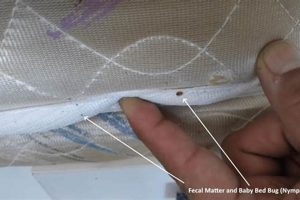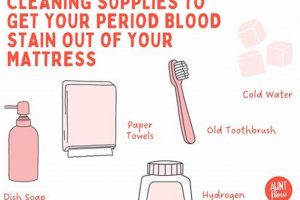Addressing persistent odors embedded within mattresses, particularly those originating from urine, necessitates specific cleaning and deodorizing techniques. Urine, upon drying, leaves behind concentrated uric acid crystals, which are the primary source of the lingering malodor. Simple surface cleaning is often insufficient to eliminate this smell, requiring deeper treatment to neutralize the underlying compounds.
Effectively resolving this issue enhances the overall hygiene and comfort of the sleeping environment. Lingering odors can negatively impact sleep quality and contribute to respiratory irritation for sensitive individuals. Historically, various household remedies have been employed, often with limited success. Modern approaches incorporate specialized enzymatic cleaners and extraction methods for more thorough and lasting results.
The following sections will outline proven methods for completely neutralizing urine odors embedded deep within a mattress. These will include preparation, appropriate cleaning solutions, application techniques, and drying procedures designed to eliminate both the stain and the accompanying smell.
Effective Strategies for Eliminating Mattress Urine Odors
The subsequent guidelines offer practical advice for successfully neutralizing urine odors that have permeated a mattress, thereby restoring a sanitary and comfortable sleep surface.
Tip 1: Immediate Action: Prompt attention to the affected area is critical. The longer urine remains in the mattress, the deeper it penetrates and the more difficult it becomes to remove the odor.
Tip 2: Absorb Excess Liquid: Before applying any cleaning solutions, thoroughly blot the area with clean paper towels or absorbent cloths to remove as much residual urine as possible. Apply firm pressure to draw the liquid out of the mattress fibers.
Tip 3: Enzymatic Cleaner Application: Utilize a specifically formulated enzymatic cleaner designed to break down the uric acid crystals responsible for the odor. Follow the manufacturer’s instructions for proper application and dwell time.
Tip 4: Thorough Saturation: Ensure the affected area is adequately saturated with the enzymatic cleaner. This will allow the enzymes to penetrate deep into the mattress fibers and neutralize the urine crystals.
Tip 5: Extended Drying Time: Allow the mattress to air dry completely. This may take several hours or even days, depending on the humidity and ventilation. Use fans or a dehumidifier to expedite the drying process.
Tip 6: Baking Soda Deodorization: After the mattress is dry, generously sprinkle baking soda over the treated area. Baking soda is an effective odor absorbent. Allow it to sit for several hours, or preferably overnight, before vacuuming thoroughly.
Tip 7: Steam Cleaning (Optional): For persistent odors, steam cleaning can be employed as a supplementary treatment. However, it is crucial to extract as much moisture as possible after steaming to prevent mold growth.
Adhering to these procedures provides a high probability of effectively eradicating urine odors from mattresses, resulting in a cleaner, fresher, and healthier sleeping environment.
The following section provides preventative measures to minimize the occurrence of future incidents.
1. Prompt Action
Prompt action is a critical determinant in the success of efforts to neutralize urine odors embedded within a mattress. The porous nature of mattress materials allows urine to rapidly penetrate, increasing the surface area affected and binding more tightly to the fibers. Delayed intervention enables the urine to saturate deeper layers, making subsequent removal significantly more challenging and potentially necessitating more aggressive cleaning methods.
The immediate absorption of excess liquid prevents further saturation and reduces the concentration of uric acid crystals that bond to the mattress fibers. For example, blotting the area within minutes of the incident can limit odor penetration to the upper layers. In contrast, allowing urine to sit for several hours or overnight enables it to permeate deeply, potentially requiring multiple cleaning cycles or even professional intervention. The timeframe significantly impacts the effectiveness of enzymatic cleaners, as they work best when applied to fresh stains.
In summary, the timeliness of the response is a key factor influencing the ultimate outcome. Swift action minimizes penetration, simplifies the cleaning process, and increases the likelihood of complete odor removal. Addressing the issue promptly is therefore not merely a suggestion, but a crucial step in successfully restoring the mattress to a hygienic and odor-free state. Delaying action amplifies the problem and increases the effort and resources required for effective remediation.
2. Enzyme Cleaners
Enzyme cleaners play a crucial role in effectively addressing urine odors in mattresses. Unlike conventional cleaning agents that merely mask or superficially remove stains, enzyme cleaners target the underlying source of the malodor: uric acid crystals. Their unique mechanism of action makes them particularly well-suited for deeply embedded organic compounds responsible for persistent smells.
- Mechanism of Action
Enzyme cleaners contain specific enzymes, such as protease and urease, which catalyze the breakdown of complex organic molecules, including uric acid, into simpler, odorless compounds. This process effectively digests the urine crystals rather than simply covering them up or dislodging them, resulting in a more thorough and lasting odor removal.
- Targeting Uric Acid Crystals
Uric acid crystals are notoriously resistant to conventional cleaning methods. They bond strongly to mattress fibers, making them difficult to remove through surface cleaning alone. Enzyme cleaners specifically target these crystals, breaking them down and facilitating their removal, which is necessary for complete odor elimination.
- Deep Penetration
The enzymatic action allows for deeper penetration into the mattress fibers compared to many surface cleaners. This is particularly important for older stains, where urine has had ample time to soak deep into the mattress. The enzymes can reach these deeper pockets, ensuring complete neutralization of the odor-causing compounds.
- Specificity and Safety
Enzyme cleaners are designed to target organic stains and odors, making them relatively safe for use on most mattress materials when used as directed. However, it’s always advised to test the cleaner on an inconspicuous area first. Their targeted action minimizes the risk of damage or discoloration compared to harsher chemicals.
In summary, the effectiveness of enzyme cleaners in eliminating urine odors from mattresses stems from their ability to specifically target and break down uric acid crystals. Their deep penetration, safety profile (when used correctly), and complete odor removal make them a superior choice for restoring a fresh and hygienic sleeping environment.
3. Complete Saturation
Complete saturation, in the context of eliminating urine odors from mattresses, refers to thoroughly wetting the affected area with a cleaning solution, typically an enzymatic cleaner. This step is critical for the solution to reach and neutralize all urine deposits, ensuring effective odor removal. Inadequate saturation will likely leave residual uric acid crystals, resulting in the persistence of the smell.
- Penetration Depth
Mattress materials are typically porous, allowing urine to seep deep into the fibers. Complete saturation ensures that the cleaning solution penetrates these layers, reaching the uric acid crystals lodged within. Insufficient saturation will only treat the surface, failing to address the underlying cause of the odor. A real-world example would be comparing two cleaning attempts: one with a light spray resulting in odor rebound, and another with thorough soaking leading to permanent removal.
- Enzyme Activation
Enzymatic cleaners require sufficient moisture to activate the enzymes responsible for breaking down the uric acid crystals. Complete saturation provides the necessary liquid medium for these enzymes to function effectively. Without adequate moisture, the enzymes remain dormant, reducing their ability to neutralize the odor. Consider a scenario where a dry patch remains untreated, negating the overall cleaning effort.
- Contact Time
Complete saturation prolongs the contact time between the cleaning solution and the urine deposits. This extended contact allows the enzymes to thoroughly break down the uric acid crystals, maximizing odor removal. Insufficient saturation results in reduced contact time, limiting the effectiveness of the enzymes. A longer soak often correlates with a more complete breakdown of the odorous compounds.
- Prevention of Re-emergence
By reaching all urine deposits, complete saturation minimizes the risk of odor re-emergence. Residual uric acid crystals can reactivate when exposed to moisture or humidity, causing the odor to return. Thorough treatment eliminates these residual deposits, providing a long-lasting solution. Avoiding incomplete cleaning prevents future odor problems.
Therefore, complete saturation is not merely a suggestion but a fundamental requirement for successfully eliminating urine odors from mattresses. It ensures that the cleaning solution reaches and neutralizes all urine deposits, activating the enzymes, prolonging contact time, and preventing odor re-emergence, ultimately contributing to a cleaner and more hygienic sleeping environment. Skimping on saturation is a false economy, as it increases the likelihood of repeated cleaning attempts and ultimately prolongs the problem.
4. Thorough Drying
Thorough drying is a crucial step in completely neutralizing urine odors in mattresses. Residual moisture can exacerbate the problem, leading to mold growth and a resurgence of the original odor. Proper drying techniques ensure that the cleaning process is fully effective and prevents secondary issues.
- Preventing Mold and Mildew Growth
Damp mattresses provide an ideal environment for mold and mildew to flourish. These organisms not only generate unpleasant odors but can also pose health risks, particularly for individuals with allergies or respiratory sensitivities. Thorough drying eliminates this moisture, inhibiting the growth of these microorganisms and preserving the integrity of the mattress. Failure to adequately dry increases the likelihood of subsequent microbial contamination.
- Inhibiting Re-emergence of Odors
Uric acid crystals, the primary source of urine odors, can reactivate when exposed to moisture. Even after cleaning with enzymatic solutions, residual moisture can trigger a renewed release of odors. Thorough drying ensures that any remaining crystals are inert and unable to generate smells. Incomplete drying effectively creates a reservoir for future odor release.
- Maintaining Mattress Integrity
Prolonged dampness can degrade mattress materials, leading to structural damage and reduced lifespan. Moisture can weaken fibers, cause clumping of fillings, and compromise the overall support provided by the mattress. Thorough drying prevents these structural issues, preserving the investment in the mattress. Moisture accumulation accelerates mattress decomposition.
- Accelerating Volatilization of Cleaning Agents
Many cleaning solutions, including enzymatic cleaners, leave behind residues that can contribute to odors if not properly dried. Thorough drying promotes the volatilization and dissipation of these residues, ensuring that only the neutralized uric acid crystals remain. Inadequate drying traps these cleaning agents, potentially leading to new or altered odor profiles. Complete evaporation of cleaning solutions enhances the overall result.
The relationship between thorough drying and effective urine odor elimination is undeniable. Preventing mold growth, inhibiting odor re-emergence, preserving mattress integrity, and facilitating the evaporation of cleaning agents are all dependent on achieving a completely dry state. Neglecting this step compromises the entire cleaning process and can lead to recurring problems. Proper drying, utilizing techniques like fans, dehumidifiers, and natural airflow, is therefore an indispensable component of a successful remediation strategy.
5. Odor Absorption
Odor absorption plays a crucial role in effectively eliminating urine smells from mattresses. This process involves the use of materials or substances that can capture and neutralize odor-causing molecules, effectively removing them from the air and the mattress fibers. When urine penetrates a mattress, uric acid crystals form, which are the primary source of the persistent smell. While enzymatic cleaners break down these crystals, odor absorption complements this process by removing any lingering volatile compounds. For example, baking soda, a common household item, is a potent odor absorbent due to its amphoteric nature, allowing it to react with both acidic and alkaline molecules, encapsulating them and preventing their release. This is especially significant in deeper mattress layers where enzymatic cleaners may not reach effectively, or where the uric acid breakdown has not been entirely comprehensive.
The practical application of odor absorption often follows initial cleaning attempts. After blotting excess liquid and applying an enzymatic cleaner, a generous layer of baking soda is spread across the affected area and left for several hours, typically overnight. This allows the baking soda to interact with and absorb any remaining odor molecules. Vacuuming removes the baking soda, carrying away the captured odors. This method can be particularly effective in cases where the urine stain is old or extensive. Additionally, commercially available odor absorbers, such as activated charcoal or zeolite, can be used in a similar fashion, offering a potentially higher absorption capacity for severe cases. These materials can be placed in porous bags or containers near the mattress to draw out lingering smells.
Odor absorption is a critical component of a comprehensive strategy to eliminate urine smells from mattresses. While cleaning and enzymatic breakdown address the source of the odor, odor absorption removes residual volatile compounds, preventing the return of the smell. The challenge lies in selecting appropriate absorbent materials and ensuring sufficient contact time for effective capture of odor molecules. Understanding the synergistic relationship between cleaning, enzymatic action, and odor absorption is essential for achieving long-term odor control, leading to a cleaner and more hygienic sleeping environment.
6. Preventative Measures
The implementation of preventative measures directly correlates with the avoidance of protracted and often challenging endeavors to remove urine odors from mattresses. The presence of urine within a mattress is an event that necessitates immediate and often complex intervention. By preemptively addressing potential sources of contamination, one minimizes the likelihood of urine saturation, thereby reducing the need for extensive cleaning processes. These preventative actions serve to protect the mattress, ensuring its longevity and maintaining a sanitary sleeping environment.
One primary preventative measure is the utilization of waterproof mattress protectors. These barriers act as a physical shield against liquid penetration, containing spills and preventing urine from reaching the absorbent layers of the mattress. Consistent use of such protectors mitigates the direct contact between urine and the mattress fibers, simplifying subsequent cleaning efforts should an accident occur. For example, in households with young children or elderly individuals, waterproof protectors are essential in preventing urine damage. Regular inspection and maintenance of these protectors are also paramount to ensure their continued efficacy.
In summation, preventative measures are a cost-effective and efficient approach to mitigate the challenges associated with urine contamination in mattresses. By employing strategies such as waterproof mattress protectors, the risk of urine saturation is significantly reduced, thereby minimizing the need for intensive cleaning and odor removal procedures. Ultimately, prioritizing prevention is more pragmatic than repeatedly addressing the consequences of urine-related incidents. This strategy safeguards the mattress, extends its lifespan, and contributes to a cleaner, more healthful sleep environment.
Frequently Asked Questions
The following section addresses common inquiries regarding the effective elimination of urine odors from mattresses, providing clarity on best practices and potential challenges.
Question 1: Are all cleaning products equally effective at removing urine odors?
No, not all cleaning products are equally effective. Conventional cleaners may mask the odor temporarily, but enzymatic cleaners specifically designed to break down uric acid crystals are demonstrably more effective at completely eliminating the source of the smell.
Question 2: How long does it typically take to completely remove urine odors from a mattress?
The duration varies based on the severity of the stain, the age of the incident, and the methods employed. Fresh stains treated promptly may require only a few hours, while older, deeply penetrated stains could take several days and multiple treatments.
Question 3: Can sunlight effectively eliminate urine odors from a mattress?
Sunlight can provide some deodorizing benefit due to its ultraviolet radiation, which can help break down organic compounds. However, it is not a reliable sole method for eliminating deeply embedded urine odors and is best used as a supplementary treatment after proper cleaning.
Question 4: What are the potential risks of using harsh chemicals to clean a mattress?
Harsh chemicals can damage mattress materials, cause discoloration, and leave behind harmful residues that can irritate the skin and respiratory system. The use of gentler, enzyme-based cleaners is generally recommended.
Question 5: Is professional mattress cleaning necessary for all urine odor removal cases?
Professional cleaning is not always necessary, but it is recommended for severe or persistent odors that do not respond to DIY treatments. Professional services possess specialized equipment and expertise to thoroughly clean and sanitize mattresses.
Question 6: Can urine odors be completely eliminated from all types of mattresses?
While complete elimination is the goal, the success rate can vary depending on the mattress material and construction. Mattresses with highly absorbent materials or complex internal structures may pose a greater challenge.
In summary, successful urine odor removal from mattresses requires the appropriate cleaning agents, timely intervention, and, in some cases, professional assistance. Understanding the principles of odor elimination increases the likelihood of achieving a fresh and hygienic sleeping environment.
The following section will address the selection of products and tools for this process.
Achieving Complete Elimination
The preceding discussion has delineated essential strategies to get rid of urine smell in mattress, underscoring the necessity of immediate action, appropriate cleaning agents, and thorough execution. The persistent nature of urine odors, stemming from deeply embedded uric acid crystals, necessitates a multi-faceted approach encompassing enzymatic cleaners, complete saturation of affected areas, and rigorous drying protocols. Prevention through the use of mattress protectors is also a key component of long-term maintenance.
Complete and effective odor removal is paramount to maintaining a hygienic and healthy sleeping environment. By understanding and implementing these strategies, individuals can successfully mitigate the challenges posed by urine contamination, ensuring a clean, comfortable, and odor-free mattress for enhanced rest and well-being. Addressing the source of the problem requires a deliberate and thorough effort, resulting in a significant improvement in the overall quality of the sleeping environment.







